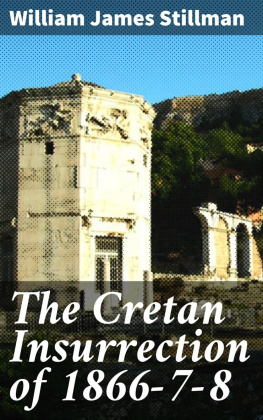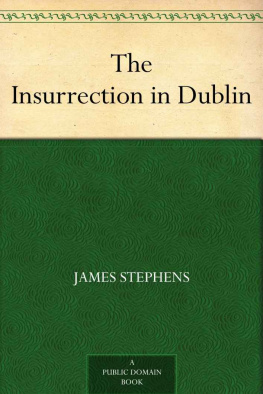The Cretan Insurrection of 1866.
INTRODUCTORY.
Table of Contents
A student of classical ethnology, curious to restore the antique man, can do no better, so far as the Greek variety is concerned, than to go to Crete and study its people. The Cretan of to-day preserves probably the character of antiquity, and holds to his ancient ways of feeling and believing, and, within the new conditions, as far as possible of acting, more nearly than would be believed possible, and affords a better field of investigation into the nature of the classical man than any existing records.
The island is one of those paradisiacal isolations which facilitate civilization in its early stages, and preserve it from the encroachments of progress in the later. Its low latitude secures it against cold in winter, and its insular position against extreme heat, while the range of high mountains running longitudinally through it gives its climate a salubrity possessed by no section of the world's surface so near the sun. The standard summer temperature is from 82 to 86 Fahr., and once only in a residence of nearly four years I saw it as high as 92. The minimum was 52. Wild flowers never are wanting except in midsummer. The almond blooms in February (I have seen it in blossom on Christmas), and all the known fruits follow it in succession, each finding some locality and climate suited to it.
The fertility of the plains, and the inaccessibility of its mountain fastnesses, made prosperity easy and conquest difficult, while its remoteness from the shore of either continent made ancient invasion not easy, and preserved the type of the composite Greek race from the barbaric innovations of Greece proper, so that we have the Greek race of B.C. 700 undoubtedly more purely preserved than anywhere else.
Only in prosperity and weight in mundane matters, in comparative consideration, they have passed to the other end of the scale from that in which Homer could say of their land: "There is a country, Crete, in the midst of the black sea, beautiful and fertile, wave-washed roundabout, with a population infinite in number, and ninety cities. The races are different, and with different languagesthere are Achans, there are the huger Eteocretans, the Cydonians, the crest-waving Dorians, and the divine Pelasgi. Theirs is Gnossus, a great city, and theirs is King Minos, who talked nine years with great Jove."
This enumeration has evidently no relation to chronological order, and unfortunately we have no intelligible traditions as to the order of settlement in Crete. Diodorus Siculus says that "the first inhabitants of Crete dwelt in the neighborhood of Mount Ida, and were called the Idan Dactyls." But Scylax says that, according to early Greek tradition, Cydonia (in the western end of the island) was known as "the mother of cities." Its position and character of site indicate rather a settlement of Pelasgi coming from the west.
Spratt finds in the geological record clear evidence of the Greek Archipelago having been formerly a fresh-water lake or series of lakes, and, if this be true, Crete must have been connected with the main lands of Europe and Asia Minor, in which case the aboriginal inhabitants would be a land migration, probably from Aryan sources. That a Phrygian colony known as the Idan Dactyls brought here knowledge of certain arts and religious mysteries, and became to the people with whom they mingled, semi-divine, appears probable. The subsequent visit of the Tyrian Hercules, who, on his way to get the cattle of Geryon, called here as the rendezvous of his forces, and, to recompense the Cretans for their friendship, purged the island of wild beasts, may indicate a Phnician colony or passing expedition.
But admitting, as of possibility, that the Eteocretan was a land emigration, cavern-dwelling, as the abundance of the caves in the island suggests; a collation of all the traditions makes it probable that the first important immigration was Pelasgic, and from the Italian shores, noted in many Greek traditions as the Tyrrhenian Pelasgi (Etruscans?), whose colonies came down by the Morea and the isles of Cerigo and Cerigotto by easy journeys to Crete. [The records of Karnak show that, in the reign of Thotmes III., a great migration of Cretan Pelasgi came into Egypt, and became the Philistines (Pilisti or Pilisgi); proving that at this early period the hive was so full that it had begun to swarm.]
This first immigration became, if my conjecture goes to the mark, the Cydonian stockthe subsequent one which Homer speaks of as Pelasgic, being of much later date; the Dorian, which was of the highest importance in its effect, as finally assimilating or subjecting all other races, and the Achan, a scarcely influential influx, coming within the recognized traditions. The author of the "Isles of Greece" supposes two aboriginal races in the island, a needless multiplication of "original Adams," though an Asiatic or Phrygian race coming in at the east, and a Pelasgic at the west, seem to have been the first recognizable elements in the population.
The myth of Jupiter and Europa is regarded as concealing the history of the introduction of the worship of the moon by a Phnician colony, who, combining with the population of the eastern end of the island, whose peculiar deity was Jupiter, produced the race over which Minos came to rule, from this fabled to be the son of Jupiter and Europa. The journey of Europa along the river Lethe indicates the course of this colony to the capital of Minos, Gortyna, which more anciently had borne the name of Larissa, a Pelasgic name, from which we might conjecture that it was founded by the colony of Teutamos, who, with a band of Dorians, Achans, and Pelasgi, the builders of all the early Greek cities, is said by the early historians to have arrived in Crete three centuries before the Trojan war, and to have settled in the eastern part of the island, and given the early city its Pelasgic name.
The present inhabitants betray differences of character so great as almost to indicate difference of race. The Sphakiotes are larger of build, more restless and adventurous, thievish and inconstant, turbulent and treacherous, than the people of any other section. The Seliniotes, in the western extremity, are the bravest of the Cretans, but less turbulent or quarrelsome, not given to stealing, and of good faith. In the eastern end, especially the region of Gortyna and Gnossus, the blessings of the rule of Minos seem to rest in pacific natures. The great Dorian invasion, about 1,000 B.C. , gave the island a dominant caste, uniformity of language and customs, but without complete fusion of races.
The language of Crete to-day is a Dorian dialect, and preserves many characteristics noted by the ancient authors. The use of Kappa as c is used in Italian, either hard or soft (in terminal syllables generally the latter), the use of r for l, especially with the Sphakiotes, and the presence of many words in modern Cretan which have disappeared from modern continental Greek, with a comparative rareness of Turkish words, and entire absence of Albanian and Sclavonic, show how much less the Cretans have been affected by outside influences than other parts of the Greek community. I give a few of the words which retain their ancient form more closely than on the continent:











